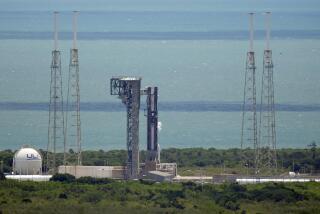After a pair of a historic arrested landings aboard an aircraft carrier, a U.S. Navy drone aborted a third landing because of a malfunction in one of its three redundant navigation computers.
The X-47B drone was four miles out Wednesday, with its landing gear down, when the unmanned vehicle reported to the mission operator that one of its computers had an issue. The landing was called off and the drone returned to shore, as per policy and the drone’s pre-planned logic.
Navy officials said the anomaly was a great learning moment on a day that they hailed as a landmark in aviation. An unmanned aerial vehicle had never before glided onto an aircraft carrier at sea.
Escorted by two F/A-18 jets, the experimental bat-winged drone designed by Northrop Grumman first landed on the aircraft carrier George H.W. Bush off the coast of Virginia at 1:39:50 Eastern time Wednesday.
Coming in at 124 knots, the 38,000-pound aircraft caught the No. 3 arresting wire on the flight deck. The landing was largely controlled by the drone’s onboard computers. It was considered a marvelous feat because of the space constraints and variable conditions at sea. Traditional combat drones need far more remote control by a human pilot.
In a call with reporters Thursday, Rear Adm. Mat Winter, executive officer for unmanned aviation and strike weapons, said he was proud of his team that “truly explored, discovered and matured the connectivity, digitization, algorithms and secret sauce.”
Less than an hour after the first landing, the drone took off from the aircraft carrier and soared into the sunny sky above the Atlantic Ocean. It landed a second time, grabbing the No. 2 wire as it came in at 118 knots.
It was the first time the Navy had simultaneously operated a drone with other aircraft onboard a carrier and the first time that it demonstrated end-to-end operations of a drone at sea.
The malfunction that led to the third aborted landing is still being investigated.
“The thing we really learned is, again, when you’re flying that close to other aircraft and personnel, you have to design it with unprecedented levels of system reliability and safety,” said Capt. Jaime Engdahl, the Navy’s manager for the drone-test program.
By the end of the year, the two X-47B craft will be retired and likely sent to museums. Carrier drones to be used in combat operations may not be delivered for several years.
The Navy plans to practice more landings with a different X-47B drone Monday. It also expects to test air refueling using surrogate aircraft, rather than drones, sometime this year.
In addition to Navy officers, about 40 military civilians and 60 Northrop Grumman employees have been involved in the X-47B demonstration program.
“It was a great day,” Northrop Grumman Vice President Carl Johnson said Thursday. “A lot of success based on having a really integrated Navy industry team.”
ALSO:
Navy drone X-47B lands on carrier deck in historic first
June retail sales rise 4.1%; biggest jump since January
U.S. properties in foreclosure fall 14% in June, report says











